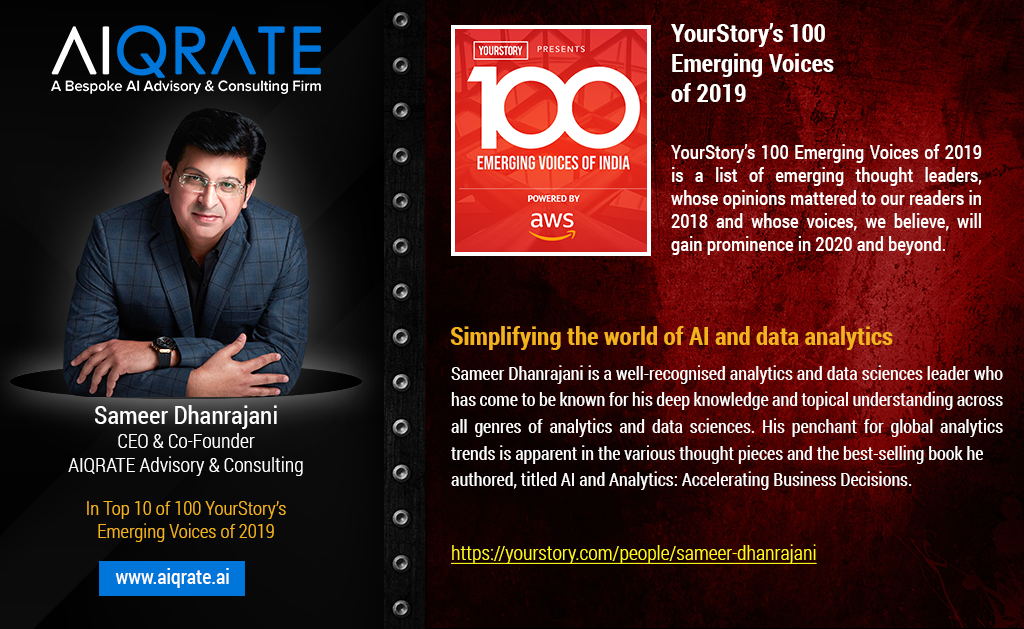
Sameer Dhanrajani in top 10 of 100 YourStory’s Emerging Voices 2019
Add Your Heading Text Here

YourStory’s 100 Emerging Voices of 2019 is a list of emerging thought leaders, whose opinions mattered to our readers in 2018 and whose voices, we believe, will gain prominence in 2020 and beyond.
Sameer Dhanrajani is featured in top 10 of 100 Emerging Voices of 2019.
Simplifying the world of AI and data analytics
Sameer Dhanrajani is a well-recognised analytics and data sciences leader who has come to be known for his deep knowledge and topical understanding across all genres of analytics and data sciences. His penchant for global analytics trends is apparent in the various thought pieces and the best-selling book he authored, titled AI and Analytics: Accelerating Business Decisions.
Read more at: https://yourstory.com/people/sameer-dhanrajani
Related Posts
AIQRATIONS
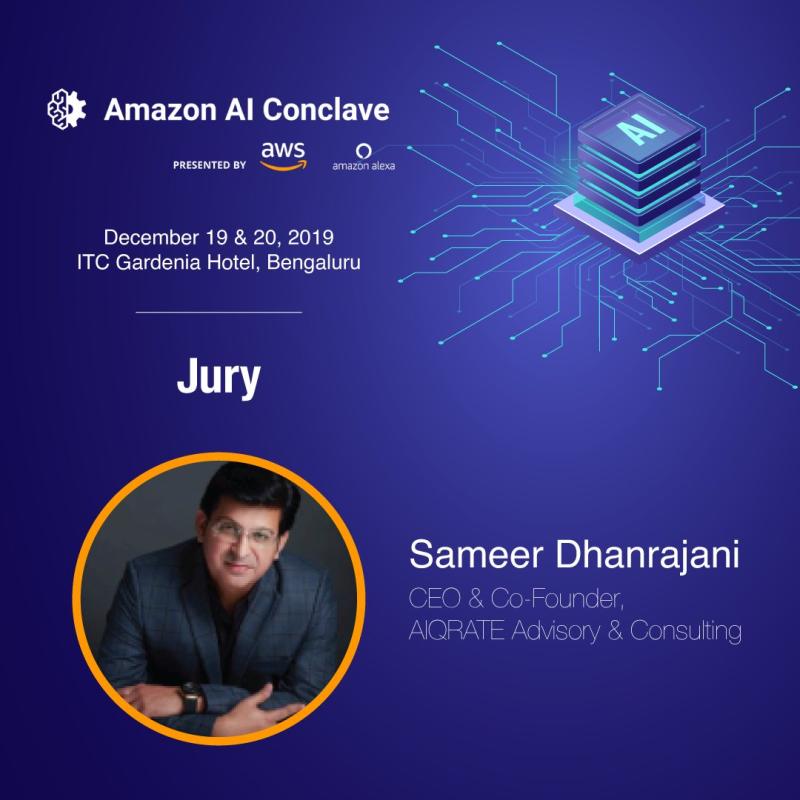
AIQRATE at Amazon AI Conclave
Add Your Heading Text Here

Meet Sameer Dhanrajani, CEO & Co-Founder, AIQRATE Advisory & Consulting, jury member at the Amazon AI Conclave on December 19-20, 2019.
Related Posts
AIQRATIONS
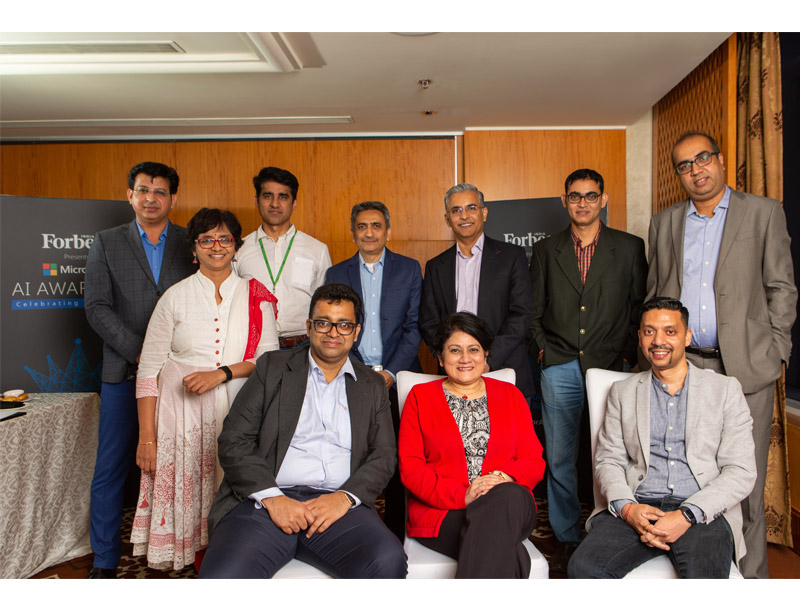
AIQRATE at AI Roundtable organized by Forbes & Microsoft
Add Your Heading Text Here

A group of CXOs from several enterprises in Bengaluru came together recently at a round table organised by Forbes India in partnership with Microsoft. They discussed the state of AI and its impact on innovation in their businesses. Below are the edited excerpts:
“Whether we like it or not, AI is absolutely all-pervasive. It’s been there for about 50 years as a technology, but the adoption rate has gone up significantly in just the last four to five years due to multiple reasons – capability, visioning algorithms, better underlying infrastructure to make it run and just the sheer drive of the industry to drive more and more ROI.” said Rohit Adlakha, chief digital and information officer and global head, Wipro HOLMES at Wipro. “Human capability is getting pushed to the limits. How do we augment that with a certain technology that can work hand in hand, while not truly replacing them, but more in terms of enhancement? Looking at the size and scale of a seven billion population across the globe, it is clear that mere technology adoption will not get us there. Something as drastic as an Uber to the power of Uber is what we need actually to make this happen.”
“In terms of AI, adoption is really happening now — it’s no longer just theoretical. Some factors that are helping this are first, the ecosystem. Second, the computing power, the actual physical infrastructure for all this that we have today.” said Satyakam Mohanty, founder of Lymbyc, an AI startup, which has been acquired by Larsen & Toubro Infotech. “One of the challenges is that people are looking at technologies instead of problems. This is creating a lot of silos. If instead, one looked at the problem that needs to be solved and then asked how AI can be applied, then you have a better way to solve this. To get to the world hunger solving stage, you have to industrialise AI, which doesn’t exist today.
Right now, all of the conversation we’re having is the mechanics of how do you make these things operational, but for adoption beyond or even within organizations for larger issues, we have to look at the risk factor.” Satyakam explains further. “Because, as with any technology or business process, there is always a risk factor, right? And the larger the organization, the greater the risk, therefore, slower the adoption that’s the standard paradigm, so how do you de-risk it?”
“At Tech Mahindra we always ask – How can I bring AI into it? The use cases that we did initially were more towards leading process automation or IT operations automation and so on. Now, we have also invested in an open-source AI project called Acumos with AT&T, one of our largest customers,” said George Mundassery, senior VP and global head, Automation and AI at Tech Mahindra. Acumos AI is a platform and open source framework that makes it easy to build, share, and deploy AI apps. Acumos standardises the infrastructure stack and components required to run an out-of-the-box general AI environment. This frees data scientists and model trainers to focus on their core competencies and accelerates innovation. “When it comes to applying the AI and making it more and more vibrant and applying it on the ground, I’m sure that that’s when the real benefits will start to be felt,” said George.
“Companies today have no option but to adopt digital. So at every point, they have to redesign their operations, be it their supply chain or the way they connect with various networks or with customer support. So that’s where those possibilities are enormous with AI,” said Prithvijit Roy, CEO and co-founder of BRIDGEi2i, a data analytics startup. “How can we embed AI in terms of creating our customer support without talking to customers, or how do you give the client or the customer what they need without having them articulate it? So there it’s not necessarily just customer experience. How do you train machines to learn on their own and create an application?” Roy said.
“A customer of mine made this statement: ‘Can we go AI with AI?’ What he meant was can we go ‘All In with AI’!” said Sayandeb Banerjee, CEO, and co-founder of a startup The Math Company. “And then we started talking about what is really stopping us from going AI with AI. The point that came out is the democratisation of the thinking is not happening as fast or the democratisation of the ideas is not happening as fast, which in my mind is what is creating a roadblock. Most of the time, my experience is that the roadblock is really the imagination and the visions of what can be done,” Banerjee said. “If you invariably have a good vision, good leader, things are moving, when you don’t have, everybody has access to the same technology, as we have access to the same platform. Why does it finally boils down to vision from a few?”
“When AI becomes more industrial and gets embedded in many places, the question of our biases becomes more important because you’re no longer thinking about them,” said Rohini Srivathsa, National Technology Officer at Microsoft India. “Take the case of an AI driven translator that interprets a doctor as he, and a nurse as she. We are coming to assume that that’s okay. We are not questioning it because it is so much a part of our thinking that the previous data has brought the pronoun to be changed to.”
Rohini continues, “So I think it creates a bigger question as AI becomes pervasive, industrialised and democratised. Are we putting in the right checks and balances? And when I talk to organisations about checks and balances, I think in some ways it is making us think about our own values first.”
“Eventually, what we are saying is that an algorithm is more about reimagining the decision making in your enterprise,” said Sameer Dhanrajani, CEO and co-founder of AIQRATE, an AI consultancy. “Now, if historically, all the decisions in the boards by the CXOs have been taken in the usual manner, in the conventional organisational structure, that may not be relevant anymore. But when you have an algorithm that works for you – embedded let’s say in the value chain of your business and doing a trade for you – it is, therefore, top of the mindshare for boardrooms, senior leaders, CXOs. Eventually, everyone is saying – look we want AI to revolutionise or reimagine our decision making.”
Sameer clarifies further, “if AI is about mimicking the human brain, organisations must have strategies, which are not defined piecemeal, isolated ad-hoc projects, or the Geek Squad. That’s a fundamental challenge.”
“Where AI is going, I think the new systems will be objective basically because you say I just want to increase my visitors to my store by 5 percent and that’s what it should do — help you make the right changes,” said Atul Batra, CTO at Manthan Software Service. “That’s the sophistication one is looking for. So basically, the systems are getting much more contextual for a specific business role like a merchandiser and store operation and so on. And one is seeing a lot of those systems deployed globally by a lot of vendors. I think that’s where it’s going – where there’s continuous feedback because you’re talking to the system and you’re getting feedback, and you’re helping evolve it.”
“We work to impact livelihoods across 14 disabilities. Purpose driven approach will make people do the right AI,” said Shanti Raghavan, founder of Enable India. “With AI, I’m expecting to be able to nudge people in their journey. Can I make them better at crowdsourcing solutions? We’ve done a lot of product management on this, like, how do you get more people to be like your TripAdvisor contributors, right? So we started introducing star users. The next time somebody comes on the program and says, you know what, I’m a star user, you can see that it’s making a difference. So, we have tons of data on how people are behaving on it, how often they log in, what do they actually listen to? We have all of that. We need AI to make sense of it. Now imagine all this data for the entire country; I cannot do this without having AI.”
“The human brain is not tuned towards trust very easily. So when you look at something physical, it’s very easy to understand. But now you come back and say that beyond the computer’s physical screen there is something, which sits on the cloud, which is a bot, which runs intelligence. I’m telling you, close to 100% will disagree.” Says Rohit Adlakha, chief digital and information officer and global head, Wipro HOLMES at Wipro. “The good part is we feel that AI is going to push the limits of the human brain to do much more than what you were able to do.”
“The challenge is that if a human is ultimately going to train a data set, which is going to train data set, you will always have your biases. So given the practical situation in mind, how do you make sure that you have a larger set of people, which will nullify each other’s biases?” says Rohit. “How do you balance it? How do you augment? How do you know humans and bots coexist? How do you make sure that both coexist and build the cast factor? I think we as an industry should push to move it from an enterprise scale to a global scale.”
“There is one more point out there, which is very, very topical today – that AI itself is not enough,” said Ritwik Batabyal, chief of technology and engineering head, Next-gen Business Products at Wipro. “Now we’re talking about these large, complex unresolved documents in office use cases. I mean somewhere algorithms the best of let’s say these kinds of models cannot solve. And in some way, I think there is a facet that is being understood by enterprises, which is can you bring in behavioral science? How do you design for a subconscious mind? You can have an algorithm, but if it’s not adopted, if it’s not implemented? What’s the use there?”
“I was certainly saying when you look at the most applied systems today, it’s getting better and better in terms of cognitive, but all said and done it is coming from some pattern,” said George Mundassery, senior VP and global head, Automation and AI at Tech Mahindra. “Today, I don’t think, it’s able to tell you that decision you made is the right one,” he said.
“There is no going back in this game; once the genie is out of the bottle we can’t put it back. So it’s like any other revolution, I think it’s going to happen,” says Prithvijit Roy. “The truth is that AI is going to take care of certain kinds of jobs that are repetitive. And that’s going to have an impact because mundane work is people’s livelihood in many parts.”
“So it’s not about replacing the human with other parts; it is making humans do certain things, which they were not able to do, which is the bigger part of the story, but this is going to be an impact in the short-term, which we all know how we will face it. So, it will work with enough time to balance out and will hopefully have better augmentation with it.”
– www.forbesindia.com
Related Posts
AIQRATIONS
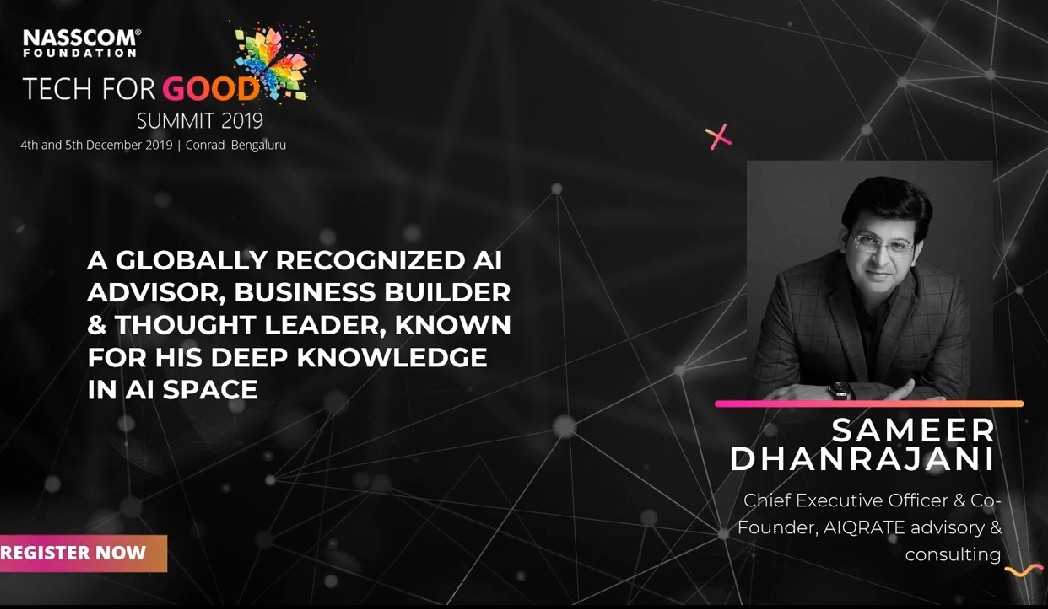
AIQRATE in NASSCOM Foundation’s Tech for Good Summit 2019
Add Your Heading Text Here

Technology has the power to disrupt status quo, alter the way people live and work, rearrange value pools, and lead to entirely new products and services to transform the future of a country.
In India today, technology has created waves across sectors. Through technology, there are skilled teachers available in remote areas addressing issues around geographical diversity, proximity, and access. There are accessibility tools, created for persons with disabilities, remote diagnostic apps, portable X-ray machines to name a few– all innovations showcasing breakthroughs in areas that were untapped until a few years ago.
NASSCOM Foundation has been encouraging ‘Tech For Good’ since its inception and through this summit it hopes to leverage innovation and collaboration to promote inclusive growth.
From the most sought after speakers in the sector, and thought provoking deep dive sessions to breathtaking social innovation exhibitions and live experiences, the Tech for Good Summit 2019 covered it all in two days – 4th and 5th December 2019.
– nasscomfoundation.org
Related Posts
AIQRATIONS

Enterprise Data Engineering Strategy: A must have for New Age organizations
Add Your Heading Text Here

“Enterprise Data Engineering” may sound dated and not so cutting-edge buzzword now. But in this age of several disruptive ideas, concepts and technologies, Enterprise Data Engineering has caught-up with all the necessary advancements and capabilities equally if not better. With organizations becoming more and more keen to be data driven and embrace AI, there is heightened necessity of robust Enterprise Data Engineering Strategy (EDE Strategy). Organizations that do not have efficient EDE Strategy laid out would be ignoring or mismanaging their data asset. Inefficient use of data asset and insights would weaken the competitive edge and their competitors will leap ahead multi-fold in no-time.
EDE Strategy being the master plan of enterprise wide data infrastructure, is a foundational component for any meaningful corporate initiative in recent years. “Explosive growth of data” is being identified as a challenge, an opportunity, a new trend, a significant asset, a source of immense insights, etc. Social media, connected devices and detailed transaction logging are generating huge stream of data which simply can’t be ignored. In simple terms, a panoramic view and wholesome control of a data setup is essential to make data a powerhouse for organizational strategic growth.
Global IP traffic annual run rate is projected to reach 3.3 zettabytes by 2021 (TV & Smartphones together will be accounted for more than 60% of this IP traffic) -CISCO
Along with changing landscape of data, associated disciplines are now aligning to the new demands. EDE Strategy ensures that, these alignments are in line with the roadmap and caters to business users and their requirements.
EDE Strategy encompasses multiple strategy elements that are seeking increased attention now-a-days due to multiple advancements in & around them. Let me introduce some of those strategy elements here:
Automated Data Ingestion & Enrichment
Data Ingestion has now become seriously challenging due to variety & number of sources (social media, new devices, IoT, etc.), new types of data (text stream, video, images, voice, etc), volume of data and the increasing demand for immediately consumable data. Data Ingestion & Enrichment are almost coming together in several scenarios. Due to this, Data Ingestion is almost going off the ETL tools and is fast adopting Pythons and Sparks. Streamed data is not just about absorbing the data as it happens at the source. It is also about enabling AI within the ingestion pipeline to perform data enrichment by bringing together needed data sets (internal & external) and making the Ingestion-to-Insight transformation automatically in seconds/minutes.
ML/AI Models and Algorithms
ML/AI infuses smartness in building data objects, tables, views and models to oversee the data flow across data infrastructure. It uses intelligence in identifying data types/keys/join paths, find & fix data quality issues, identify relationships, identify required data sets to be imported, derive insights, etc. So, the advent of ML/AI in data engineering infuses intelligence into learning, adjusting, alerting and recommending by leaving complex tasks & administration to humans.
Cloud Strategy
The most significant shift seen in the digital world recently is the amount of data being generated and transported. Studies say, 90% of the data existing today were generated in just last 2 years. This is going to increase multi-fold in the coming years. The on-prem based infrastructure and provisioning processes aren’t agile enough to scale rapidly on demand. Even if this is managed, the associated overhead of buying, managing and securing the infrastructure becomes highly expensive and error prone. So, it is essential for organizations to opt for highly efficient and intelligent data platforms on cloud. Cloud offers several advantages across cost, speed, scale, performance, reliability and security. It is also maturing away from initial IaaS into newer services and players. But it doesn’t mean organizations simply initiate the cloud migration and get it done at the press of a button. There should be a carefully drafted Cloud strategy & execution roadmap for adopting cloud in alignment to organization requirements and constraints. Data and information on cloud has the potential to give organizations the flexibility, scalability and ability to discover powerful insights. Cloud also enables applying ML/AI for discovering dark data, monetizing opportunities and disruptive business insights.
Data Lake
Among the data-management technologies most significant space is of data lake. Data Lake is not a specific technology but a concept of housing “one source of truth” data for an organization. When implemented, data lakes can hold and process both structured and unstructured data. Though name indicates huge infrastructure, data lakes are less costly to operate if on cloud. It doesn’t require data to be indexed or prepared to fit specific storage requirements. Instead it holds data in their native formats. Data is then accessed, formatted or reconfigured when needed. Though data lakes are easy to initiate due to easily accessible and affordable cloud offerings, it requires careful planning and incremental adoption model for large scale implementations. In addition, the ever-changing data regulatory & compliance standards add to challenges of implementing and managing data lakes.
Master Data Management (MDM)
Though there is ongoing debate on whether MDM is needed where data lake is the central theme. Schema-on-Write, Schema-on-Read, unstructured data, cloud, etc., are the main contention points in these debates. No matter who wins these debates, it is important for us to know more about MDM while discussing on data engineering. Because, MDM is very essential for organizations to serve their customers/clients near real-time and with better efficiency. As Master Data is the key reference for transactions, typically all independent applications maintain them locally. This leads to redundancy, inconsistency and inefficiency when these data are brought together. It becomes a big challenge while integrating and processing these data due to complexity, chances for errors and increased cost. So, it is important to address MDM element in the EDE strategy carefully by considering organization objectives. Multiple models are practiced for implementing MDM like, registry, hybrid, hub, repository, coexistence, consolidation, etc., which would be discussed in my next articles.
Visualization
Visualization is an exercise that helps in understanding the data in a visual context like patterns, trends, relations, etc. This sounds like an external element or a client to the data engineering. Then, why is Virtualization an important element in EDE Strategy?
Gone are the days of graphs and charts for human analysis. Especially due to data deluge, fitting so much information in a graph or chart is almost impossible for human-beings. They need help in building meaningful representations by consuming huge amount of data. ML/AI is the answer to this wherein its models/algorithms show patterns and correlations by studying huge data-sets in no-time. So, to enable AI to process data, it is important to arrange and label the data suiting it the best. Hence, Visualization is an important aspect to be considered while constructing an Enterprise wide Data Engineering Strategy.
Conclusion
In this new era of data being the new oil, every interest required is being taken to improve the way data is received, cleansed, enriched, assembled and transformed. EDE Strategy ensures establishing effective deployment/management guidelines and continuously improves them because data environments are living organisms. A solid EDE Strategy is highly essential to cater to the demands of this new age. All organizations must have EDE Strategy for realizing their digital vision. Ignoring to have a well laid Enterprise Data Engineering Strategy is as good as regressing in this competitive world.
Related Posts
AIQRATIONS
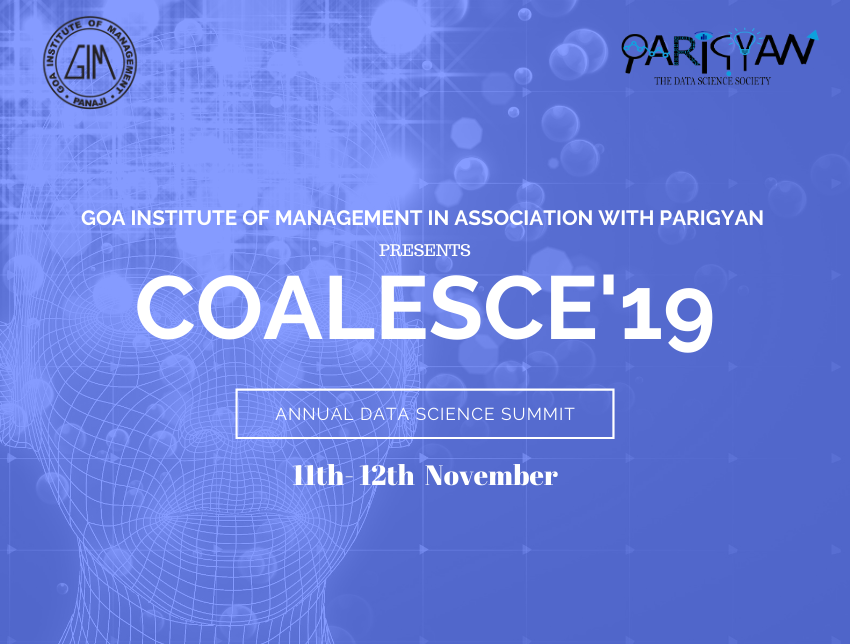
AIQRATE at COALESCE’19 – Goa Institute of Management
Add Your Heading Text Here

Goa Institute of Management (GIM), organized one of its most anticipated event, the two day long Annual Data Science Summit, Coalesce’19 at its campus in Sanquelim recently where leaders from the world of data science interacted with audiences.
Coalesce (Powered by TVS Credit) saw prominent industry leaders and experts in the field of Data Science and Analytics, delivered informative talks and shared insights on how the industry is embracing innovation as conversations grows around data analytics.
Sameer Dhanrajani, Former Chief Strategy Officer at Fractal Analytics and CEO & Co-Founder of a new venture, AIQRATE advisory & consulting delivered an electrifying session on Artificial Intelligence: The next normal in strategy and business transformation. He spoke about the direct correlation between Data and AI leading to a transformation in decision making and problem-solving.
Avik Sarkar, Head of the Data Analytics Cell of Niti Aayog spoke about the role of Big Data in Public Policies & Governance, emphasizing on how Big Data had been used in different government programs with success.
Shailendra Kumar, Vice president at SAP, addressed the audience nd shared pointers on Making Money Out of Data, and how one could create value for an enterprise using data, predictive analytics and advanced analytics. After hearing his enlightening thoughts, the podium was taken by Moumita Sarker speaking on the topic Forecasting Monsters: What hinders the usage of Forecasting techniques in business decisions. She expedited details on different techniques and scenarios where one could easily build a forecasting model that would solve the growth story.
A panel discussion on the topic: Does Analytics act as an enabler in current business models? saw panellists Srinidhi Shama Rao, Senior Partner with The Math Company, Amit Kurhekar, Global Technology Manager, Aparana Gupta and Sameer Dhanrajani, CEO of AIQRATE share insights in a session moderated by Prof. Hemant Padhiari.
Coalesce ’19 also included a 2-day workshop organized in association with Sankhya on Artificial Intelligence & Machine Learning which witnessed a Datathon Crypto sponsored by TVS credit where about 240 teams participated and the top 10 teams from different B-schools visited the campus for the final round.
– By NewsExperts.in

